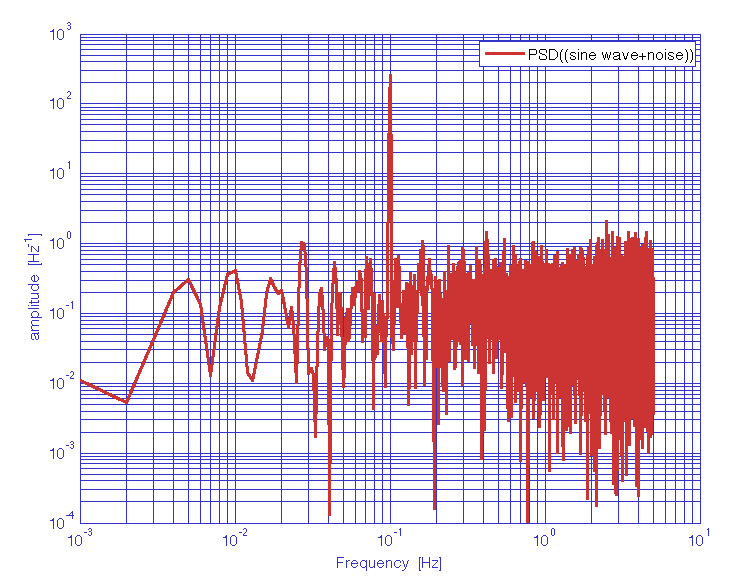

| LTPDA Toolbox™ | contents |   |
Spectral windows are typically used in spectral analysis algorithms. In all LTPDA spectral analysis functions, spectral windows are specified as parameters in an input parameter list. The following example shows the use of ao/psd to estimate an Amplitude Spectral Density of the time-series captured in the input AO, a. The help for ao/lpsd reveals that the required parameter for setting the window function is 'Win'.
% Parameters
nsecs = 1000;
fs = 10;
% Create input AOs
x1 = ao(plist( 'waveform', 'sine wave', 'f',0.1, 'A',1, 'nsecs',nsecs, 'fs',fs));
x2 = ao(plist( 'waveform', 'noise', 'type', 'normal', 'nsecs',nsecs, 'fs',fs));
% Add both
x = x1 + x2;
% Compute psd with Blackman-Harris window
z = psd(x,plist('win','BH92'));
% Plot
iplot(z);
In this case, the size of the spectral window (number of samples) may not match the length of the segments in the spectral estimation. The psd algorithm then recomputes the window using the input design but for the correct length of window function.

The table in the previous section shows how each standard spectral window is defined by the Peak Side-Lobe level (psll). However, Kaiser's window allows the user to define the psll of the window.
The following example shows the importance of selecting a suitable psll according to each application. The example creates 1/f noise (in fact, noise generated by a pole-zero model with a pole at low frequencies) and computes the Amplitude Spectrum Density (ASD) with three different psll values. The ASD with the lowest value shows a bias at high frequencies compared with the response of the pzmodel used to generate the data (in black). This effect is due to the power added by the high order lobes of the window. The ASD with the highet value of the psll adds a feature at low frequencies because the main lobe of the window is too wide. Only the middle value gives an estimation of the ASD without adding window related features.
% Parameters
nsecs = 10000;
fs = 1;
% Create pzmodel with a low frequency pole
pzm = pzmodel(1e5,[1e-7,0.1],[]);
% Build (nearly) 1/f noise
x = ao(plist('pzmodel',pzm, 'nsecs',nsecs, 'fs',fs));
% Compute psd with Blackman-Harris window
z1 = psd(x,plist('scale','ASD','win','Kaiser','psll',50));
z1.setName('psll = 50');
z2 = psd(x,plist('scale','ASD','win','Kaiser','psll',100));
z2.setName('psll = 100');
z3 = psd(x,plist('scale','ASD','win','Kaiser','psll',1000));
z3.setName('psll = 1000');
% Plot
r = resp(pzm,plist('f1',1e-4,'f2',1));
r.setName('response')
r.setPlotinfo(plist('color','k'))
iplot(z1,z2,z3,abs(r));

 |
What are LTPDA spectral windows? | Spectral Estimation Methods |  |
©LTP Team